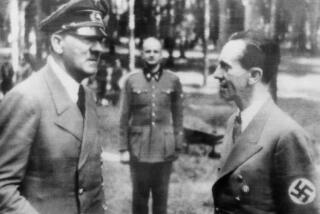A Biographical ‘Bah, Humbug’ on the Cherry Tree : Washington: The legend meant to encourage truth-telling was itself a fabrication.
- Share via
No other great man in history has had to live down such a mass of absurdities and deliberate false inventions. . . . Only those who willfully wish to deceive themselves need waste time over an imaginary father of his country amusing himself with the fictitious cherry tree and hatchet. --William Roscoe Thayer The famous “I cannot tell a lie” episode, it seems, was a lie itself--a wholesale fabrication by the Rev. Mason Weems, a hack writer and alleged plagiarist.
After George Washington’s death in 1799, Weems realized that Americans were hungry for stories about their hero and happily obliged with a series of “biographical” pamphlets, beginning in 1800. By the 1806 pamphlet, the juvenile lumberjack and his cherry tree had made their appearance. Starting in 1808, that episode would reappear in dozens of subsequent editions of Weems’ book, “The Life of George Washington: With Curious Anecdotes, Equally Honourable to Himself and Exemplary to His Young Countrymen.”
But what kind of example did George set for his young countrymen and countrywomen? Consider the conclusion of Weems’ original tale:
“ ‘George,’ said his father, ‘do you know who killed the beautiful little cherry tree yonder in the garden?’ This was a tough question, and George staggered for a moment, but quickly recovered himself, and looking at his father with the sweet face of youth brightened with the inexpressible charm of all-conquering truth, he bravely cried out, ‘I can’t tell a lie, Pa; you know I can’t tell a lie. I did cut it with my hatchet.’
“ ‘Run to my arms, you dearest boy,’ cried his father in transports, ‘run to my arms; glad am I, George, that you killed my tree; for you have paid me back a thousandfold. Such an act of heroism in my son, is more worth than a thousand trees.’ ”
Levelheaded readers may find the tolerance and forgiveness of George’s father a bit much to swallow--as if Adam could have gotten off the hook by frankly admitting to God that the apple was quite tasty. To real-life parents, young George seems to have resorted to the truth because no other option was available. Children, as well, sometimes boggle at this unrealistic story of delinquency rewarded; in a 1904 issue of Life magazine, a schoolboy-poet wrote:
My pa ain’t like Washington’s pa.
When I cut down our cherry tree,
And said I did, pa walloped me.
And I went up to bed and cried
And golly, how I wish I lied.
Biographers of Washington are boggled for another reason: America’s enduring vision of its truth-telling first President is the result of a lie cooked up by the scurrilous Weems. This isn’t folklore, they protest, but fakelore.
Still, Weems was only doing what Longfellow did when he made America’s then short history into the stuff of legends by writing “Paul Revere’s Ride,” “The Courtship of Miles Standish,” “Evangeline” and “The Song of Hiawatha.” Understood in this fashion, young George and his hatchet really belong in the equally mythical company of Paul Bunyan and his ax and Betsy Ross and her nimble needle.
More to Read
Sign up for our Book Club newsletter
Get the latest news, events and more from the Los Angeles Times Book Club, and help us get L.A. reading and talking.
You may occasionally receive promotional content from the Los Angeles Times.







